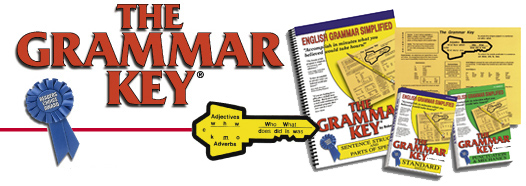The GrammarKey Sentence Structure & Parts of Speech CD | The GrammarKey Puncutation & Mechanics CD
The GrammarKey Workbook | The GrammarKey Card Pack | GrammarKey Diagram | View Video | Reviews
Research | FAQs | Pricing for Institutions | Pricing for Individuals
Frequently Asked Questions
WHAT IS THE GRAMMAR KEY?
The Grammar Key is a traditional, hands on approach to English. It focuses on understanding grammar rules and applying those rules to writing. It is designed for students from elementary school through college having difficulty in writing; for teachers who are not necessarily English majors; for teachers who want an alternative method to teaching grammar; and for teachers of English as a second language. It consists of three levels of understanding—Beginning, Intermediate, and Advanced—and can be used with any textbook from elementary to college.
WHAT DIFFERENT LEARNING STYLES DOES THE GRAMMAR KEY INCORPORATE TO ENCOURAGE ACTIVE LEARNING
Auditory—Students hear specific verbal cues and then cooperatively recite the words, which they are encouraged to apply to each specific skill.
Visual—The Grammar Key visually reinforces grammar identification. The strategic location of grammatical terms in both the computer program and the reference cards help students recall information at a glance.
Kinesthetic—Words and symbols take on a physical representation, meeting the needs of students, who learn best by manipulatives, while the key reference cards allow a hands on approach to grammar.
HOW DOES PROFICENCY IN GRAMMAR CONTRIBUTE TO STUDENTS' WRITING?
Students who feel comfortable with their ability to use proper grammar are better able to concentrate on the fluency of ideas during writing activities. They become free to express ideas rather than labor over the mechanics of grammar. Once internalized, grammar becomes the invisible cement that bonds structure to writing and turns incoherent word groups into clear, crisp sentences.
CAN THE GRAMMAR KEY BE USED IN COOPERATIVE LEARNING SITUATIONS?
When students collaborate, they communicate their collective body of grammatical knowledge to one another. The Grammar Key computer program provides just this opportunity, even drawing out students of varying degrees of ability and encouraging them to work together in order to solve writing problems and complete their assigned tasks.
DOES THE GRAMMAR KEY RECOGNIZE THE SPECIAL PROBLEMS ASSOCIATED WITH LEARNING DISABLED STUDENTS OR LEP (LIMITED ENGLISH PROFICIENCY) STUDENTS?
The Grammar Key activities invite all students—even those considered “at risk”—to participate in each lesson, using whole class oral exercises and peer tutoring. It allows the instructor to target specific concepts and meet individual needs, while in the process, tearing down preconceived inadequacies the students may have and creating an atmosphere of confidence and equality.
HOW CAN THE GRAMMAR KEY IMPROVE THE TEACHING OF WRITING?
Writing captures thoughts. Just as an artist strives for perfection in his or her work, so can the student strive to achieve a higher level of expression in his or her writing. Effective writing can be learned and improved—and an effective writing tool can measure that improvement. The Grammar Key provides that tool. It allows the instructor to work at different skill levels without compromising the equality of instruction; to identify specific concepts where the student is having problems; and to reinforce those areas the student has already mastered. With The Grammar Key, the student sees each sentence as a body of related skills working together, and grammar becomes an internalized process he or she automatically applies to writing.
|
Why Teach Grammar on a Computer? Since grammar is systematic, it can be taught on a computer, and since a computer never gets tired, it can repeat those key words and grammatical patterns to the extent that they become internalized in the students’ minds. |
|
What’s the difference between The Grammar Sentence Structure & Parts of Speech and The Grammar Key Punctuation & Mechanics? It might be helpful to examine the punctuation error in this sample sentence: "When students know the structure of a sentence and the parts of speech they have no problem grasping the rules of punctuation." You must also know the punctuation rule that states a comma always follows an introductory clause before the main clause begins. THIS IS WHAT WE TEACH IN THE GRAMMAR KEY PUNCTUATION & MECHANICS CD-ROM. Then the answer is simple: "When students know the structure of a sentence and the parts of speech, they have no problem grasping the rules of punctuation." |
